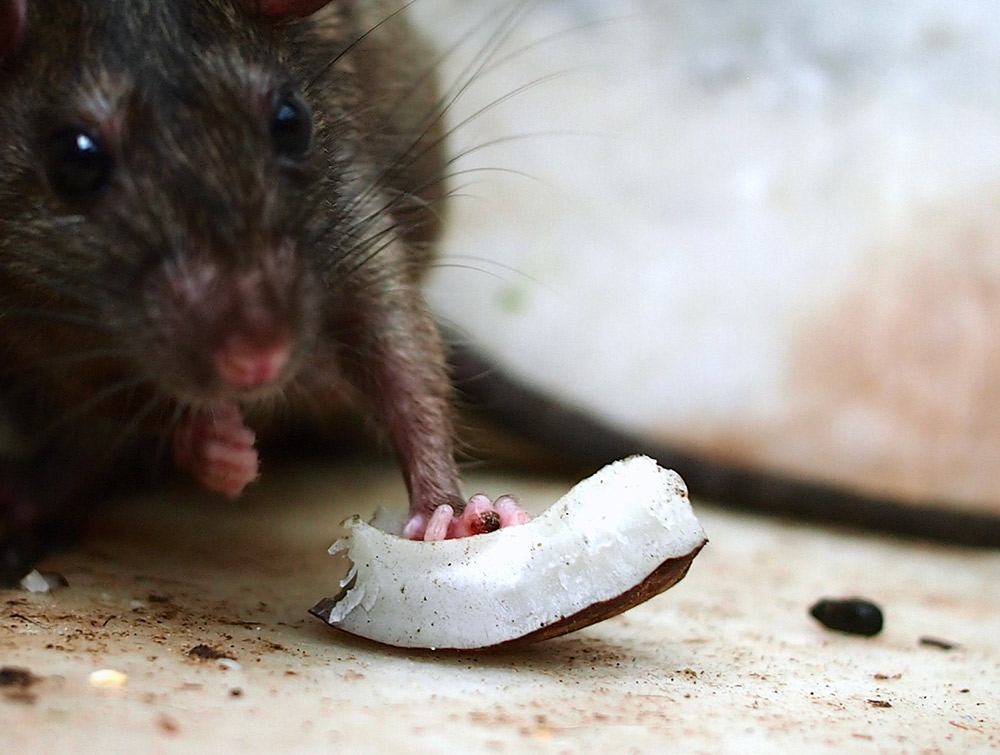I have been an arachnophobe for most of my life. This unfortunate phobia stemmed from a family member’s decision to take me to see Raiders of the Lost Ark when I was two years old. The one brief scene where Indiana Jones is covered in tarantulas did it for me, for life. So while arachnids are off-limits to this wandering nomad, many other animals that freak fellow travellers out don’t bother me. Case in point: rats.

Rats running the show at Karni Mata temple in Rajasthan.
This is a good thing, because on my trip to India we visited the Karni Mata rat temple. According to legend, the first rat temple was built in Rajasthan in the 1400s. It was then that a Charan mystic named Karni Mata, who was an incarnation of the goddess of power and victory, Durga, made a deal with the god of death. She had attempted to reincarnate the son of a storyteller, only to be told by Yama — the god of death — that he had already been reincarnated.
As Yama refused to help her, Karni Mata promised that members of her Charan caste would be brought back as rats. Following their death as rats, they would be reincarnated as people once more, as members of the Depavats family. Thus the deal Karmi Mata struck with the god of death was that her people would all be reborn as rats, until such time as they could be born back into her tribe. As a Westerner without a culture that believes in reincarnation, this legend sounds like a fairy tale. But to Hindus, where death marks the end of one chapter in life and the beginning of another journey of souls, it is an important religious story. For Hindus, paying respects to Karni Mata’s present-day rats is a way to bring good luck to one’s family and potential good fortune. Pilgrims come from elsewhere in India to visit the modern iteration of the rat temple, built in the 1900s by Ganga Singh of nearby Bikaner. Built in the Mughal style, the temple comprises a huge marble façade with silver doors that describe legends of Karni Mata.

Paying respects to Karni Mata, including prostrating on the floor.

The ornate silver gates of the Karni Mata temple.
We visited the Karni Mata temple as part of my Land of the Maharajas tour, and the group was split between “freaking out about the rats” and “curious about the rats, but not looking to get up close and personal with them.” It got more interesting when our guide informed us that we would need to be barefoot; it is considered good luck to have these special rats run all over your feet. It is also good luck to eat food and drink water that was previously sampled by one of the rats, but none of us planned to give that one a try. Of all the auspicious rat-related activities, seeing an albino rat is the luckiest — they are considered the holiest of the lot. Sadly, we did not see any during our visit.
Thankfully we were permitted to wear socks, and we stopped at a local market to pick up pairs that we all planned to discard after the temple visit. I’m all for integrating into local culture, but as an immunocompromised human, I was relieved to have a thin layer of cotton between me and the rat-filled floor.
Inside the temple, the 20,000 rats that inhabit it run freely, some eating and some sleeping awkwardly on metal railings. Called kabbas (little children), the rats subsist on seeds, milk, and coconut shells. They are fed by the Depavats family, temple devotees of Karni Mata herself. Some of these devotees live in the temple full time, others come in to clean and leave once again.

Rat holding a coconut shell.

Mealtime for the rats.

Yes, he’s sleeping.
They were far smaller than the rats I was used to seeing in New York, which often grew to alarming “almost a cat” sizes. The Karni Mata rats were sized more like mice, and were actually quite cute — until two Indian teenagers behind me decide to scare the daylights out of me. When you enter the temple you have the option of shuffling behind the shrine of Karni Mata herself, via a passageway that is pitch black. As I wandered through, the gentleman behind me took the opportunity to throw rat food all over my feet, luring in a swarm of rats, which made a beeline for my socks. I must have jumped a foot in the air, which set the teens off, laughing uncontrollably. By the time we emerged, blinking in the daylight, my white socks were full of rat prints and the two teenagers were doubled over with mirth.

I made new friends at the Rat Temple, but pranking teenage boys weren’t among them!
Despite the fact that rats are looked down upon by many of us, especially with their role in transporting diseases like the plague, our guide noted that the Karni Mata temple has never had an outbreak of disease — confirmation to him that these rats were indeed special. India is a complicated country with many languages and cultures that make up its whole. Experiencing Karni Mata was an interesting reframe of reincarnation as not always including the most elegant of animals. Being a tiny temple that many tourists did not want to step foot in, it also afforded a more intimate view of what it means to pay respects as a Hindu in today’s India.

Pilgrims arrive at Karni Mata in Rajasthan.

Pilgrims entering the temple.
Recommended, unless you’re musophobic — in which case no amount of cajoling will make this a place you want to visit.
Getting There
Thinking of India? Rajasthan awaits on the Land of the Maharajas tour. We’re thrilled at the prospect of showing you this big blue planet of ours — check out our small group trips here.























